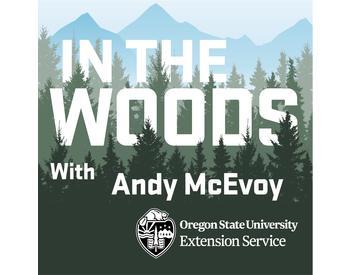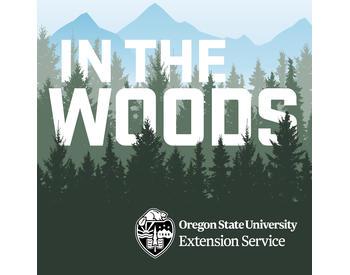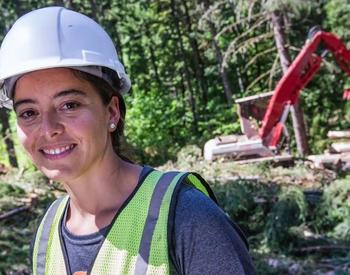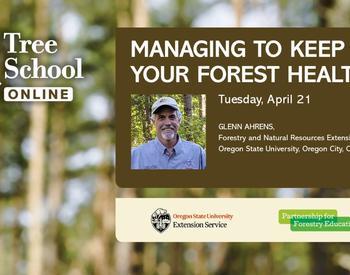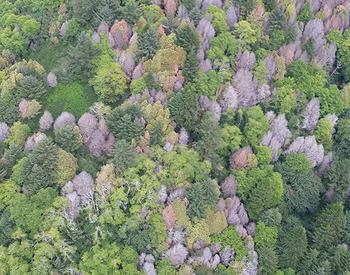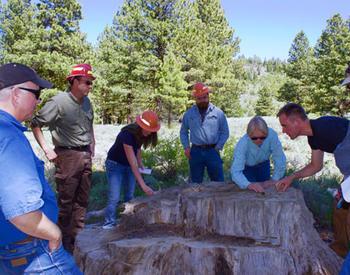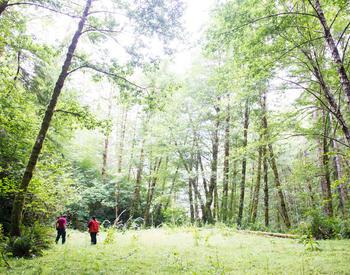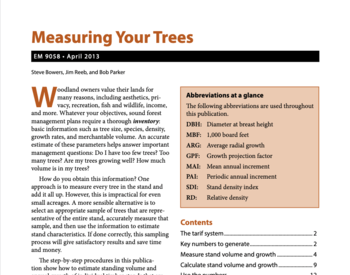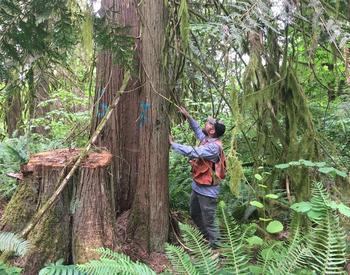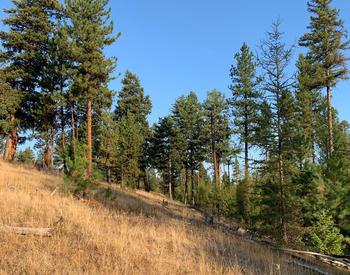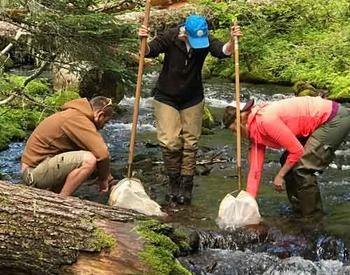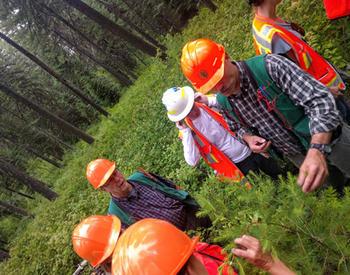Transcript
From the Oregon State University's Extension Service, you are listening to In the Woods with the Forestry and Natural Resources Program. This podcast aims to share the voices of researchers, land managers, and members of the public interested in telling the story of how woodlands provide more than just trees. They provide interconnectedness that is essential to your daily life. Stick around to discover a new topic related to forests on each episode.
And we are rolling. All right, well, welcome back to the In the Woods Podcast, presented by the Forestry and Natural Resources Extension Program at Oregon State University.
I'm Scott Leavengood uh, extension specialist in wood products at OSU, and I'm the host for today's episode on a truly tasty topic, maple syrup. I am joined today by a couple of experts on that subject, Eric Jones and Eliza Nelson. And without stealing any of your thunder, I'll allow you both to introduce yourselves.
So, Eric, please introduce yourself and tell our audience a bit about what you do. Hi, Scott. Thanks for, uh, having me. I'm a anthropologist by training and uh, I work in the College of Forestry at OSU. I grew up in Oregon, born and raised here. Worked on farms, forests. Uh, grew up in South Salem. We had lots of cherry orchards and things around.
So, um, I've grown up picking lots of wild fruits and vegetables and things. So, uh, I'm excited to be getting into Maple Tapping and other tree tapping. As a maple sugaring. Is that a major focus of your work at OSU? It is now. Um, two years ago, uh, we applied for funding to begin research, um, put a team together.
They funded us. We applied again, they funded us again. So we have back to back grants that stretch over a five year period. And, uh, that's gonna be really, uh, helpful as we, uh, learn all about, uh, maple tapping here in the northwest, and, and figure out, uh, the best ways to go about it and how to potentially, uh, help a commercial industry grow.
Fantastic. All right. And I neglected to mention when I called on you first there that, uh, you're out in the field now, so if our audience hears any background noise, you'll, you understand why that is. He's actually at, uh, Morning Mist farm out near Sherwood. And Eliza, Eliza Nelson, why don't you tell our audience who you are and what you do.
Hello. Thanks Scott. So glad to be here. I run an educational nonprofit called the Oregon Maple Project. We started, um, at around the same time Eric and his crew started at OSU in 2020. And we make big leaf maple syrup with students and community members and host visitors for workshops, field trips, and work parties at our Sugar Shack in Colton.
All right, great. And to, uh, continue the conversation here, I can probably anticipate the question on top of many listeners' minds, even though you've already tipped your hand. And we know that it's possible. But you know, anybody wondering now, why an episode on maple syrup for listeners on the West Coast?
We don't make maple syrup in the Pacific Northwest and we or we can't or, or can we, Eliza? We can. The question you get off and I'm guessing, yeah. It is, and that is something that I was delighted to discover, uh, since I am originally from New England and fell in love with the process of making maple syrup in Vermont.
Um, and in the Pacific Northwest we tap the abundant big leaf maple tree and have the pleasure of tromping around in our wet green winter woods. Anything to add to that, Eric? Do you get that question often too? Yeah, I, I think it, it, it's because it's not common here. I, I think there's, oh, probably going way back, probably, uh, you know, millennia maybe with the, uh, native American Indian tribes in the region.
We don't know. We haven't heard stories yet. We're certainly interested in learning about that history if it emerges. But I imagine as settlers came to the northwest, um, from New England and Canada and uh, uh, even earlier, the first fur trappers that they saw Maples and probably realized you could tap them and tried, and a few probably got some sap and boiled it down and, and boiled, and boiled, and boiled and even though there's not as much sugar in our maple trees, but, you can get, uh, syrup at at the end if you're patient, but it's because of that low sugar content I think that there hasn't been the same sort of long cultural growth of hobbyists and commercial industry as there is in the Northeast.
Okay, so you've already touched on a little bit. The next thing I was gonna ask you is about the, the concentration or yield differences. So, uh, quite a bit lower concentration of sugar. So we get lower yield per tree, that sounds like. But, um, how does the taste compare to the syrup from New England and Eastern Canada?
Uh, all let me address the, the sugar content a little bit and turn it over to Eliza for taste. Uh, so we have about, uh, one to one and half percent sugar. We call it bricks. And uh, in sugar maples it's two to three and half, so you know, roughly half or a little less than half the sugar content. But because of, uh, recent technologies in the last couple decades becoming affordable and geared to the maple industry, including specialized tubing and vacuum pumps and reverse osmosis machines.
That's suddenly even the playing field. So vacuum pumps allow you to hook many trees up to a tubing system and efficiently collect a lot of sap, a great quantity. The reverse osmosis machine, uh, is an easy way to remove 75 to 80% of the water, and then you have less to boil. Ah, very interesting. And, and the flavor, Eliza.
What do people tell you or what do you think? Yes, um, uh, well we love hearing people's descriptions cause we are still developing the flavor profile. Um, we hear anything from caramel to butter, bourbon, toffy, um, a real variety. And our syrup is, is darker and more complex than sugar maple syrup. And we think it has the rich earth taste of our lush Pacific Northwest forests.
Um, and it really provides a succession of flavors for the palette, so you'll get more than one taste, um, in your mouth. Yeah, when I visited you at one of your workshops a couple of months ago, I, I remember, uh, had a little sip and thought, this is delicious. It was, that reminded me a little bit of molasses, and I think a few other people agreed with that as well.
But maple syrup with a molasses, uh, undertone or something like that. Yes. So how did you both get interested in, in sugaring, and that is the correct terminology, right? There's a lot of, lot of terminology to different industry sectors and I Sugaring is the right way to describe it? Yes. Yes. Okay. Eliza, how did you get interested?
My first exposure to Maple Sugaring was during high school when I attended the Mountain School in Vershire, Vermont, and that was a semester program on a working organic farm, which included a full scale sugaring operation during the spring months, and I was completely hooked. But then I settled in Oregon, fell in love with the Pacific Northwest, and became a fourth and fifth grade teacher for 20 years at Arbor School in Tualatin
Um, and when I learned about Big Leaf sugaring, I started tapping trees with my students on our campus. Then I traveled to Vancouver Island to attend their big leaf maple syrup festival put on by that, the well established sugaring community up there. And over the years, I've become more fascinated and involved and have shifted to pursue mapling, some people call it or sugaring, um, full time.
Oh, great. Yeah. And Eric, you described your, you introduced yourself as a native Oregonian, right? So how did you fall into this? Yeah, um, I, as a kid, I remember a couple elderly ladies in my neighborhood in Salem that tapped maple trees, and I wish I could go back in time and really listen more carefully to them and talk about what it is they were doing and learn their tricks, but, they, I remember getting a taste of the syrup and that always stuck with me many years later as I really got into, um, uh, researching and teaching about wild foods and medicinal plants and, uh, other non-timber forest products.
Maple was on my mind. And then I went to graduate school, uh, for my PhD at University of Massachusetts Amherst. So I to spend eight and half years in the thick of sugaring, the birthplace of maple sugaring, I guess you'd say. And, uh, I, it was all around, I was just always fascinated by, um, the, the romance and, and the deeply ingrained culture around maple tapping and the rituals of going to pancake feeds while they're cooking the syrup down, uh, on farms. And fast forward some years and I thought, well, you know, it'd be fun to try that with Big Leaf. I had also gone to British Columbia and uh, for a number of workshops and some teaching up there. And had, uh, the chance to meet Gary Backlund in the late nineties. And he, he's an old timer.
It wasn't back then, but, uh, he was, uh, sort of the Johnny Apple seed of Maple Syruping or around there trying to teach people that yes, you can get it from Big Leaf any, he published a great little pamphlet on it. And, um, real quickly, just, uh, I sort of was sitting, sitting on all that for many years and then saw that, um, the, uh, Acer program was funding, uh, Big Leaf research.
It started, uh, University of Washington got the first grant in our region and I put in a proposal the, the next year and we got ours. And now, um, Washington States involved, and we have a great, uh, tri university, uh, collaboration going on with our separate but complimentary research projects. Great. Yeah, and I, we'll get into some of the research in a, in a little bit here, but first to just get started. For, for our listeners who, who maybe we've got a few hooked now. How would an interested listener get started? What kind of supplies do they need and who can they contact for more information and assistance? Uh, we'll start with you Eric. Yeah. Um, we are putting together public materials.
Um, uh, Tiffany, uh, Fegel and, uh, Carrie Berger had put a nice extension fact sheet together, uh, for, that's kind a good orientation for hobby tapping, um, kind of getting your toe wet and, uh, we put together a public website and we'll be updating that frequently and putting out more materials. So getting familiar with some of the literature is a good start.
Um, if you have a chance to attend one of, uh, Oregon Maple Projects, uh, events, that's a really good thing to do. We are also, Oregon State, uh, having a number of events around, we're gonna be doing more now that COVID has freed to get out there and interface with the public, so keep an eye out on our website and other places to learn how you can learn about Maple Tapping and learn what the different supplies you need, depending on what it is you wanna do.
If you just wanna do a few trees, there's some nice simple kits you can get from the East Coast, like, uh, bascom maple products. Um, CDL. Ross Sugarbush, smokey Maple. These are all on our website, but they're, they're some of the companies that put together simple little hobby kits so people can get started without investing a lot of money.
And, um, if you're lucky enough to run into us, we might have some extra, uh, buckets and bags and different things we've tried that we have surplus for, and we're always happy to, uh, give out any extra things that we might have so you can contact me. Great. Okay. Well, we'll be sure on the, uh, in the Woods Podcast website to provide links to some of the, those resources that you just described there.
How about, how about you, Eliza? What, um, what would you advise an interested listener about getting started? What I love about sugaring is how simple and elemental it really is. We can get really fancy or we really, we look down, look at it, all we need to do is drill a hole in a maple at the right time of year, collect its sap and boil it to concentrate the tree's, natural sugars.
So anyone can go mapling with a drill in a bit, a spout or a spile, as we call it, um, a recycled collection jug, which could just be a milk or a water jug. A stove and a pot. Um, so it's very accessible and that's something we want people to know, that it's, it's really worth a try.
Um, and you can expand, um, into all kinds of efficient, fancy, updated methods. But, um, there's a lot to be said for just the simplicity of interacting with the trees. Yeah, great. And I, you just started a bit there talking about the process, so I'll let you, uh, continue here. How to tap, you drill a hole in the tree, you put a smile in there or a tap.
Um, and when, when do you, when should you do that and what, what are characteristics of a tree that make it a good candidate, like size, age, location, those sorts of things, Eliza? Mm-hmm. Yeah. Well, our season for Big Leaf sugaring is quite long, starting in late November and running until March. We typically wait until the trees have lose their leaves to begin tapping, and we remove the taps when the tree begin budding in the spring.
Um, so, and what we're looking for in when we begin, which is right about now, um, is a series of freezing nights, um, followed by days above freezing, so a freeze thaw cycle. And, and that will happen periodically throughout our Pacific Northwest winters. Young big leaf maples are really vigorous, fast growing trees that often provide more sap than older big leafs.
So we tend to tap trees that are as small as six inches in diameter, and we find that trees with wet feet growing near streams, lakes, or other moist areas are really excellent sap producers. Great. Uh, Eric, anything you would add to that? Yeah, you know, we started with trying to, uh, draw from what Gary Backlund had written in his book on, uh, in British Columbia on big leaf maple tapping, but also really, uh, study the northeastern sugar maple industry methods and see um, begin to see how much of it worked, and, and most of it does. Most of it, as Eliza says, is pretty simple. It's not real complicated.
But we have some variables here, like, uh, our cyclical winter weather that with warm periods and that can cause, uh, problems like bacteria to grow in, in buckets or taps or lines, whatever you're doing.
And so we're learning how to, um, mitigate that and develop some procedures and advice for people. So, the you know, there's a whole bunch of technology too that can fall into this. So if you have a maple tree on the valley floor, you can tap it after a freeze and, and you'll probably get, uh, some sap or you might have several.
And I advise tapping more than one because for some reason sometimes you can tap two trees, uh, one right next to each other will flow great, and the other won't flow at all. So there's lots of under the ground or in the tree and its own cycles that we don't really understand that well. So there's a little bit of, uh, uh, you know, safety in numbers.
You know, try and try, you know, if you tap one and you don't get any sap, don't get too discouraged. Cause that could be, uh, nature, just, uh, you know, working in its mysterious way. True. Very true. Yeah. And I'm, I'm sure that many people here are wondering about the impact on the tree's health. Does tapping trees harm them, Eric? Uh, yes. When you drill a hole in a tree, it creates a wound and, uh, sap will hopefully flow through that. And, uh, when you pull the tap or spile out, the tree is gonna begin the process of trying to heal itself. And, uh, bacteria will fill that hole. And that's another process we don't fully understand yet.
But, um, it, that next year, if you were to cut that tree in half right where that spile was, you would see some non-conductive wood, uh, uh, above and below and um, probably a little to the side, so it creates a little bit of dead wood and in the sugar maple industry. So for Ace or Saccharum, the sugar maple.
Uh, they are very careful in the Northeast when they put in a tap hole because those trees grow very slowly. Um, they're dormant, frozen, solid for most of the winter in many places, and, uh, they don't have as long a growing season. Here with Big Leaf, uh, these trees grow so rapidly and put on new wood so quickly, um, I don't think the tap hole is as a, is as a big a concern.
Uh, it's not, it's something to be mindful of and be aware of, but, you know, if you know maples and if you are a tree farmer, uh, growing Conifer, maple was, has, you've probably seen it as the enemy and tried to eradicate it, and that is, the, the typical, uh, approach to big leaf maple in, in the stands where the conifers are growing that you wanna harvest, uh, they might be left alone in riparian areas, uh, hopefully.
And, um, in those cases, the, um, the maples, uh, are very hard to kill. I mean, you, you know, you, you're very lucky if you can ultimately kill all the maples in your property. So when you clear cut or thin or whatever you gonna do, if you create a big open space in that canopy, those maples, they're gonna come up outta nowhere.
You're gonna be like, oh, I thought I. So, um, they are extremely tenacious. They, in the winter, the limbs break off and, and they just, they, they grow new sprouts all the time. I mean, they, it's very different species in the sugar maples. That's one of those things that we, you know, we can't carry over as, as well.
Okay, that's good to know. That's a long way of saying it does hurt the tree, but I think, uh, it's such a hearty tree it's very unlikely that it would ever kill it, even if you tapped dozens and dozens of times. All right. Okay. Good to know. Yeah, they're resilient. That's good. Um, what, what do you tell people, Eliza, when they ask you a similar question, does this hurt the tree?
And especially you, you must have worked with the, you said young people. What, what was their impressions? Right, right. It's a question that people often ask and do worry about. Um, rightfully so. Um, but I agree completely with Eric that the big leaf maple is a survivor and, um, a really pretty remarkable tree.
And it can often be very hard to find last year's tap holes on in a big leaf maple, especially the young ones because the tree heals over them so quickly and completely. Through its own growth. Um, and I, I like to compare sap extraction in trees to blood donation in humans. If it's done in a careful moderated, sanitary way.
There are few health side effects, um, but we are keeping an eye on, especially on the climate stresses that are being experienced by the big leaf maple along with all, all other trees in our northwest forests. Um, and we're making a practice for sure of tapping only the healthiest looking trees. For example, avoiding trees that had powdery mildew on their leaves, um, this summer and letting leaving them be for now.
Good, yeah. So, um, what are some of the pitfalls people should look out for? Uh, you know, what, what can go wrong, Eliza? I would say one thing we've learned is that, um, we can move our taps. So if we put taps in in early December, and a month later we're not. We have some good weather conditions, but we're not getting any more sap.
Um, we, we find that if we just move them and drill a new tap in the same tree, we'll put in a new clean spile that will start getting production again. So it the, the big leaf maples, because our season is so long and because big leaf maples are so vigorous, they, the trees start to heal over the files, um, within a month to six weeks, which then slows the flow of sap.
So it can be, uh, a pitfall to think, oh, okay, the season is done. But what we've really learned is that we can, we can start again mid-season. Interesting. How about, how about you, Eric? What, what kind of pitfalls do you see? Yeah, the, the thing I preach the most, uh, to people I'm teaching how to do setups and tap is to practice hygiene.
Um, if you can keep your system free from bacteria by, you know, cleaning your tubing, your spiles, your buckets. If you're using reverse osmosis, those machines real carefully. Any collection tanks or buckets, bags, whatever, keep it all as clean as you can, and it's not hard to do. You can just use, uh, very simple little, uh, food grade non-toxic sanitizer like, uh, star sand or a low dilution of hydrogen peroxide.
So, uh, otherwise, once, once the you know, bacteria, the, the yeast takeoff and start feeding your sap goes sour. We haven't, it's unlikely that there's gonna be, um, dangerous pathogens in it. We are doing food safety research and, and testing, uh, this year especially really trying to work with Oregon Department of Ag, to create some nice simple procedures so as people scale up to commercial they're ready.
But, nonetheless, you know, having good hygiene will help keep good, tasty sap because, uh, when your, when your sap goes bad, um, well you might be able to still boil it and make it into something that would make a good beer, but it's probably not gonna make very tasty syrup. Okay, interesting. Now I've focused here on Maple because that's the species we're all familiar with, but our, our other species being explored as, as sources of syrup.
I'll start with you again, Eric. Um, what other species are being looked at? Yeah, um, we get asked that a lot and we are definitely starting to, uh, look at English walnut 'cause there's a lot of, uh, walnut orchards that are kinda being taken out of production. And so there's an opportunity there maybe to tap them.
Uh, Walnut makes a, a delicious sweet syrup. Uh, like, uh, maple syrup, but different, it's, uh, stronger. Chefs, uh, uh, seem to really like it for sauces and rubs and so on. Um, Butternut, uh, you know, lots, lots of other tree, beech those kinds of trees can all be tapped. Uh, birch, uh, some of those we, we don't have native here are not, uh, very, uh, much of, so it's really big leaf.
And then probably walnut orchards are our, our main focus and we are gonna start looking at alder. Alder, uh, doesn't, uh, necessarily have a sap flow the same way, but we think maybe with some vacuum systems that, uh, we might be able to do alder and we've, we've heard that it's, um, uh, good and tasty, so, but we'll see.
I'm not putting that out there for people to go tap it and try it. I don't really know yet, but, uh, we are researching those things. Great, all right. Anything you would add to that list, Eliza? That's a pretty complete list. And I, I would just say that there is lots of interest throughout the country in alternative tree syrups.
Um, my, one of our maple colleagues, Mike Farrell in New York, has an entire business on, um, a whole range of tree syrups. Very interesting. All right. You've, you've, uh, and I'll fill in the blanks for some of the, since we're on a, this is a, despite being a podcast for you all, this is a video feed. I'm seeing the rain coming down on Eric pretty good now.
So, if you're hearing, if you're hearing some wind, uh, and the, the weather's changed dramatically since we started talking a few minutes ago here. So, um, so what sort of research... What's that? Oh, I said the chickens all ran inside. I went. Okay. Um, so you've, you've touched on some things around bacteria and other, other species.
What, what other sorts of research are happening around the, the topic, uh, Eliza? One, um, really accessible piece of research that, that I've been following and recommending people get involved with is, uh, Washington State University extension, Patrick Schultz is, has a citizen science survey, um, which anyone who's tapping just a couple of trees can, can do and fill out.
And we'll, we'll be learning more about the behavior of maples throughout the sugaring season this year. Great. Eric, do you have, uh, you have grad students working on this, on this subject, you can just talk about one of their projects, for example. Yeah. Yeah. John, uh, Chub is a grad graduate student and he's doing a, uh, sort of a systems analysis, interdisciplinary systems analysis of how Big Leaf fits into different kinds of farm forest economy.
Um, uh, he's still in the process of designing the, the, all the research questions, so looking forward to seeing where that goes. Melanie Duvall is marrying art and and science, and doing some real interesting things around how do we, uh, use art and science to reach different audiences, to teach 'em about big leaf and opportunities with big leaf maple tapping.
So that's really fun. And then our, our team has, uh, we have a number of, uh, research questions that we're, we're working on, in addition to just learning, um, about how Big Leaf can be tapped on different kinds of, uh, landscapes, different elevations, different, uh, you know, uh, systems from, you know, places that are vineyards or orchards or conifer farms and so on.
So all that's really great. We are starting to get into the soil science. We wanna look at, you know, what is the relationship between the soil and the flavor in the sap and in products? Um, there's a lot of mystery there. So, uh, it's really fun to be getting into that. We, of course, we're looking at all the food safety things and we'll be doing different tests on, um, uh, not only the bacteria and so on, but we're gonna be testing like UV light systems, uh, for non-thermal, uh, pasteurization of sap as a potential for maple water.
Uh, different things like that. So lots and lots and lots of fun things. Uh, oh, I should say, Barb. Um, our ecophysiologist, uh, on the team is, uh, doing some really fun experiments with looking at sap flow, uh, in the tree you're gonna be doing that year round.
'Cause uh, it varies a lot. We just really wanna dial into what's happening around those tap holes. So, yeah. Great all right. Yeah, lots of, like you said, art, art and science going on there. Um, so before we wrap up this episode, I have a few more questions for you in what we call the lightning round.
And the first question we always ask is, what is your favorite tree species? Okay, now, given the species we've been talking about most of the episode, can we pretty well guess what your answers are? Well, we'll see. Eric, your favorite tree species?
Oh, boy, that's a tough one. I would say maple's moving up, uh, moving up quickly. Okay. This is probably sacrilege in the Willamette Valley, but, uh, I'd probably say I, I really love Ponderosa Pines. Um, but White Oaks are big favorite of mine. Okay. Now you got me started. We got a Willamette Valley Ponderosa Pine, so that's totally acceptable.
All right? Yes, Eliza, your favorite tree species. I guess this is why we're colleagues, Eric cause yes, big Leaf maple is definitely first, but Ponderosa is my second favorite. Okay. Very interesting. Um, and what is a unique tool that you use, uh, that helps with your work? And we'll start with you, Eliza.
I just got my brand new LineViper, which is a pair of pliers that helps attach tubing to spiles and tea pins and all kinds of fittings. It's impossible to connect them well without these pliers and they're ergonomic and, uh, look really beefy and cool. Cool. LineViper. All right. And for you, Eric? Unique tool that helps with your... Well, I've been, I've been, uh, we deal in a lot of, uh, different kinds of, uh, tubing rolls and, uh, and they, they often come, uh, in, in big, uh, uh, un uns without a spool, you know, just big, big, uh, round, uh, bunches of tubing.
And we have to figure out how to unwind those without creating a rats nest. So I've been making all, all these different spoolers to, to see what works, but I just got a really cool metal, uh, one, it's a hanging basket. I got it from, uh, Canada. Pruno is the company and I'm really excited, uh, about it cause it's, uh, super simple and uh, I think it's gonna save us a lot of headaches.
Okay. Lastly, what other resources can you share related to certain production for a listener that would like to dive deeper into the subject? And I guess that's gonna be whatever we haven't already covered above. Can you, can you think of anything that, um, you'd like to dive if somebody wants to dive deep, maybe some books or something, Eric?
Um, well, uh, the North American, um, Maple Sugar Manual. Did I get that right Eliza? Um. Yes. I think that's right. Third edition. Brand new thing just came out. You can download it for free. You can probably find it at the Vermont Proctor Maple website. That's a great, uh, kind of book to give you a real great reference manual to refer to it, and it's geared to all different levels from beginners.
Mike Farrell, another Northeasterner, and one Eliza mentioned earlier, he has a book called "The Sugar Maker's Companion". Another great reference book. It also has a lot of fun history in it. That's sugar maple. So our books and, and texts for the big leaf industry, we, we've got the lot more coming in addition to Gary Backlund's uh, pamphlet, which even though some of, some of the, uh, concepts he wrote about, uh, are starting to age a little bit.
We're finding out new things. It's still a very good, readable, fun book. He put a lot of effort into it and it's a great place to start you can get it for like 15 bucks off Amazon. Great. We'll make sure to provide all that on the website for people. Um, Eliza, you get to have the final word here. What other resources? Well, as a teacher who loves poetry and nature, I always recommend Robin Wall Kimmerer's "Braiding Sweetgrass". She has a beautiful chapter on Maple sugaring and does a better job than anyone at, um, portraying the deeper meaning of the mapling endeavor.
Wow. Very interesting. Okay, great. Eric, Eliza, I wanna thank you both very much for sharing your knowledge and experience today. You have me and I'm, I'm sure, um, many of our listeners thinking about, um, having some pancakes or waffles right now. And all kidding aside, I'm glad we have this opportunity to learn about this exciting new area of interest in the Northwest.
Uh, allow you both to have a parting farewell, Eliza. Thanks so much, Scott. It's been really fun, and I look forward to spending time with my fellow Oregonians out in the winter Woods. Great, Eric. Stay dry out there. Thanks, Scott. Uh, Eliza as always, um, this is great. We're just at the beginning as something that I think is gonna have a big future in, uh, Oregon and the Pacific Northwest in general.
So come on and get out there in the woods and tap some trees with us. In the woods. Nicely done. All right, well, this concludes another episode of OSU Forestry on Natural Resource Extension's In the Woods Podcast series. Thanks for listening, and don't forget to subscribe. Bye everyone.
Thank you so much for listening. Show notes with links mentioned on each episode are available on our website inthewoodspodcast.com. We would love to hear from you, visit the tell us what you think tab on our website to leave us a comment, suggest just a guest or topic, or ask a question that can be featured in a future episode. And, also, give us your feedback by filling out our survey.
In the Woods was created by Lauren Grand, Jacob Putney, Carrie Berger, Jason O'Brien and Stephen Fitzgerald, who are all members of the Oregon State University Forestry and Natural Resources Extension team. Episodes are edited and produced by Kellan Soriano. Music for In the Woods was composed by Jeffrey Hino and graphic design was created by Christina Friehauf.
We hope you enjoyed the episode and we can't wait to talk to you again next month, until then what's in your woods?
In this episode, Scott Leavengood is joined by Eric Jones and Eliza Nelson to discuss the increasing popularity of maple syrup production in Oregon and the Pacific Northwest.


